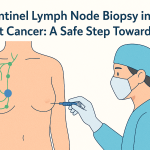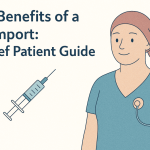
Breast Conservation Surgery (BCS)
What is Breast Conservation Surgery ??
This surgery is also called a lumpectomy or partial mastectomy. In this only the part of the breast that has cancer, along with a small margin of surrounding tissue, is removed. The rest of the breast is left as it is or reconstruction is done . This way, the breast keeps its natural shape, giving a better cosmetic outcome while still removing the cancer safely.

WHY BCS ??
This helps you maintain your natural breast shape, and it is less invasive than a full mastectomy. Recovery is usually faster and easier, and when combined with radiation, it offers a similar survival rate to mastectomy—while still giving a better cosmetic outcome.

HOW IS IT DONE ?? it is usually done under general anesthesia, so you’ll be asleep and feel no pain during the surgery. The surgeon carefully removes the tumor along with a small rim of healthy tissue around it to make sure all the cancer is taken out. In most cases, the doctor also check the nearby lymph nodes (called a sentinel lymph node biopsy or axillary staging) to see if the cancer has spread, and remove them. This helps guide further treatment.

Any Risks ??
It is generally a safe procedure. Like any surgery, a few side effects can happen, such as a wound infection or slower healing. Sometimes the breast may look a little different afterwards, with slight asymmetry or scarring. If flap reconstruction is done, rarely the flap may not heal well. The good news is that most of these side effects are temporary or can be managed easily with proper care and follow-up.
What after BCS ??
After surgery, taking care of the wound properly is very important to help it heal. You will also need regular follow-up visits so your doctor can check your recovery and make sure everything is going well. In addition, it is important to complete the additional treatments advised, such as chemotherapy or radiation therapy, as these give the best chance of cure and prevent the cancer from coming back.

Chemotherapy
Additional treatment may be needed to give you the best long-term results. This is because surgery removes the main tumor, but tiny cancer cells may sometimes remain or spread beyond the breast. Treatments like chemotherapy, hormone therapy, or targeted therapy work throughout the whole body (systemic therapy) to reduce the risk of the cancer coming back and to treat any cells that may have spread.

Radiation Therapy
After your wound has healed—usually about 2 to 3 weeks after surgery—your doctor may start Radiation . The goal of this treatment is to kill any tiny cancer cells that might still be left behind, giving you the best chance of recovery and lowering the risk of the cancer returning

Follow-up Care
After your treatment, it’s important to have regular check-ups with your doctor. You may also need scans or other imaging tests from time to time, as advised, to make sure everything is fine. Always pay attention to any new symptoms and let your doctor know right away, so they can be checked early.






